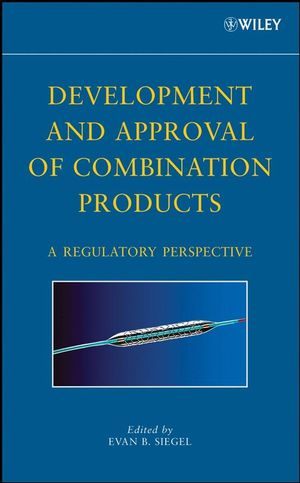Development and Approval of Combination Products: A Regulatory PerspectiveISBN: 978-0-470-05094-1
Hardcover
232 pages
May 2008
 This is a Print-on-Demand title. It will be printed specifically to fill your order. Please allow an additional 15-20 days delivery time. The book is not returnable.
|
||||||
Acknowledgments.
Contributors.
1 OVERVIEW OF COMBINATION PRODUCTS DEVELOPMENT AND REGULATORY REVIEW (Evan B. Siegel).
2 DETAILED REGULATORY APPROACHES TO DEVELOPMENT, REVIEW, AND APPROVAL (James Barquest).
2.1 Introduction.
2.2 General Background.
2.2.1 Definitions.
2.2.2 FDA Organization and Jurisdiction.
2.2.3 Clinical Investigation and Premarket Review Requirements for Drugs, Biological Products, and Medical Devices.
2.2.4 FDA Information Resources.
2.3 Combination Products: Regulatory Background .
2.3.1 Definition.
2.3.2 Intercenter Agreements.
2.3.3 Office of Combination Products.
2.3.4 Primary Mode of Action.
2.3.5 Intended Use.
2.3.6 Strategic Regulatory Considerations.
2.3.7 The Request for Designation (RFD) Process.
2.3.8 User Fees.
2.3.9 FDA Meetings: Successful Regulatory Interactions.
2.3.10 Current Good Manufacturing Practice for Combination Products.
2.4 Postmarketing Considerations.
2.4.1 Adverse Event Reporting.
2.4.1.1 Device Malfunction Reporting (21 CFR 803.3(r)(2)(ii), 21 CFR 803.20).
2.4.1.2 Five-Day MDR Reporting (21 CFR 803.10(c)(2)(i)).
2.4.1.3 Drug and Biological Product “Alert” Reporting (21 CFR 314.80(c)(1) and 600.80(c)(1)).
2.4.1.4 Blood-Related Deaths (21 CFR 606.170).
2.4.2 Other Compliance Issues.
References.
3 NONCLINICAL RECOMMENDATIONS FOR SUCCESSFUL CHARACTERIZATION AND DEVELOPMENT OF COMBINATION DRUG PRODUCTS (Duane B. Lakings).
3.1 Introduction.
3.2 Pharmacology.
3.2.1 Pharmacology and Safety Pharmacology Recommendations for CDPs with Multiple Marketed Drugs.
3.2.2 Pharmacology and Safety Pharmacology Recommendations for CDPs with Marketed Drugs and a Single NME.
3.2.3 Pharmacology and Safety Pharmacology Recommendations for CDPs with More Than One NME.
3.3 Pharmacokinetics.
3.3.1 Pharmacokinetic and Drug Metabolism Recommendations for CDPs with Multiple Marketed Drugs.
3.3.2 Pharmacokinetic and Drug Metabolism Recommendations for CDPs with Marketed Drugs and a Single NME .
3.3.3 Pharmacokinetic and Drug Metabolism Recommendations for CDPs with More Than One NME.
3.4 Toxicology.
3.4.1 Toxicology Recommendations for CDPs with Multiple Marketed Drugs.
3.4.2 Toxicology Recommendations for CDPs with Marketed Drugs and a Single NME.
3.4.3 Toxicology Recommendations for CDPs with More Than One NME.
3.5 Conclusions.
References.
4 CLINICAL PHARMACOLOGY AND CLINICAL DEVELOPMENT OF COMBINATION PRODUCTS (Chaline Brown).
4.1 Introduction.
4.2 Postapproval Clinical Safety Reporting.
4.3 Clinical Development of Drug–Delivery System Combination Products.
4.3.1 Advantages of a New Delivery Device Drug Product.
4.3.1.1 Streamlined Regulatory Process Possible.
4.3.1.2 Improvement in Efficacy over Previously Approved Delivery Routes.
4.3.1.3 Noninjection Bioavailability for Peptides and Proteins.
4.3.2 Considerations for a Combination Product with a Novel Delivery Route.
4.3.2.1 Impact of Infusion Pumps on Pharmacodynamic Effects.
4.3.2.2 Route-Dependent Pharmaceutical Metabolic Profile.
4.3.2.3 Inherent Delivery Site Sensitivity.
4.3.2.4 Addressing Concerns Regarding the Safety of Excipients in Novel Routes of Delivery.
4.3.2.5 Addressing Concerns of Possible Immune System Reactions During Development.
4.3.2.6 Addressing Effects Specific to Human Physiology During Development.
4.3.2.7 Addressing Formulation Changes During Clinical Development.
4.3.3 Case Study: Exuberaw (Pfizer’s inhaled insulin, approved January 2006).
4.4 Clinical Development of Drug–Active Device Combination Products.
4.4.1 Case Study: The Drug-Eluting Stent (DES).
4.4.2 Changing Scene for New DES Products.
4.5 Clinical Development of Co-Packaged Combination Products.
4.5.1 Co-Packaged Drug and Biologic Case Study: Interferon and Ribavirin for the Treatment of Hepatitis C.
4.6 Clinical Development of Drug–In Vitro Diagnostic Combination Products.
4.6.1 Retrospective Changes in Drug Labeling to Incorporate Genetic Tests.
4.6.2 Prospective Co-Development of Drugs and In Vitro Diagnostics.
4.6.3 Issues Surrounding Biomarker Development.
4.6.4 Clinical Trial Design Issues in Drug–In Vitro Diagnostic Co-Development.
4.6.5 FDA Guidance.
4.6.6 Case Study: Herceptinw and HercepTest®.
4.7 Clinical Development of Drug–Biologic Combination Products.
4.7.1 Case Study 1: Mylotarg® (Monoclonal Antibody Linked to a Cytotoxic Drug).
4.7.2 Case Study 2: Bexxarw (Monoclonal Antibody Linked to a Radioisotope).
4.8 Clinical Development of Drug–Drug Combinations.
4.8.1 General Considerations for FDC Efficacy Studies.
4.8.2 Case Study: CombinatoRx, with Combination Therapy as a Business Model.
4.9 Conclusion.
References.
5 REGULATORY STRATEGY CONSIDERATIONS FOR CHEMISTRY, MANUFACTURING, AND CONTROLS: AN INTEGRATED APPROACH (Patrick L. DeVillier).
5.1 Introduction.
5.2 Office of Combination Products (OCP) and Request for Designation (RFD).
5.3 Extent of Regulatory Oversight.
5.4 Investigational Device Exemption and Investigational New Drug Exemption.
5.5 Regulatory Compliant Product Development.
5.6 Chemistry, Manufacturing, and Controls Review Requirements.
5.7 Drug Component Requirements.
5.8 Device Component Requirements.
5.9 Sterilization Considerations.
5.10 Stability Considerations.
5.11 Bench Testing and Early Development Considerations.
5.12 CDP Regulatory Cross-Mapping Guidance and Recommendations.
5.13 Conclusions.
References.
List of Abbreviations.
Index.



